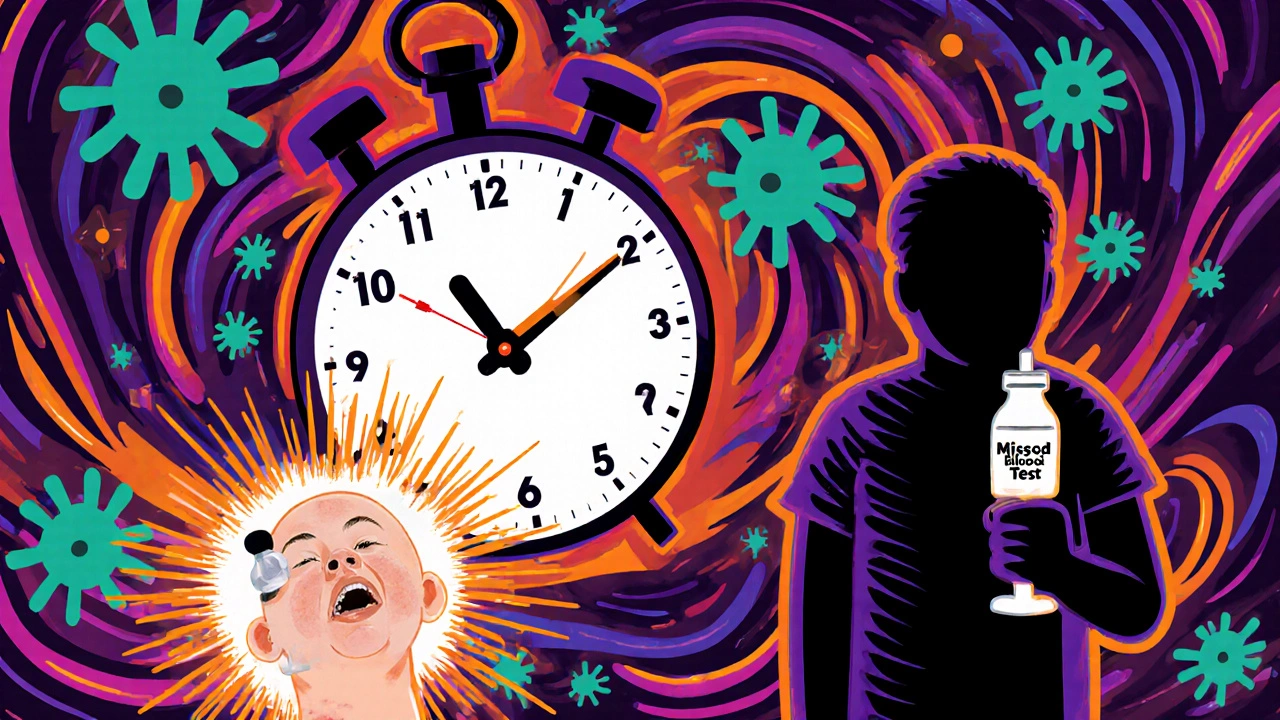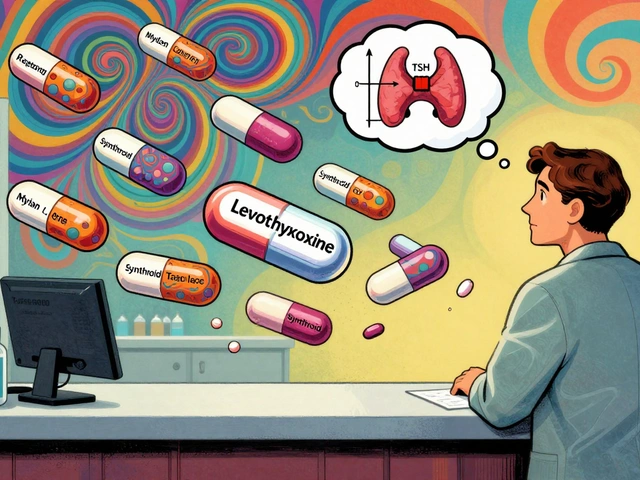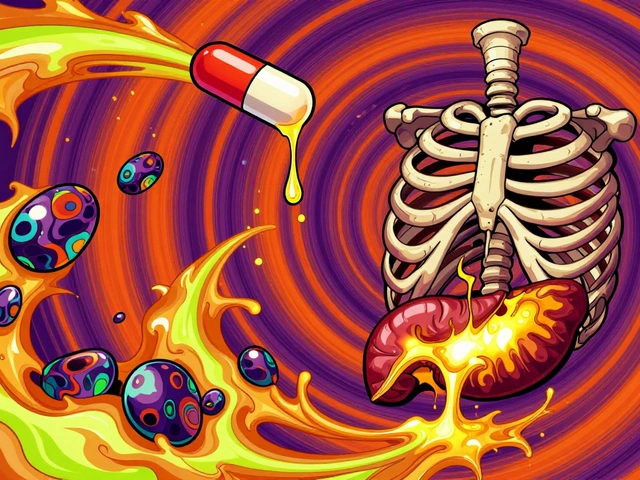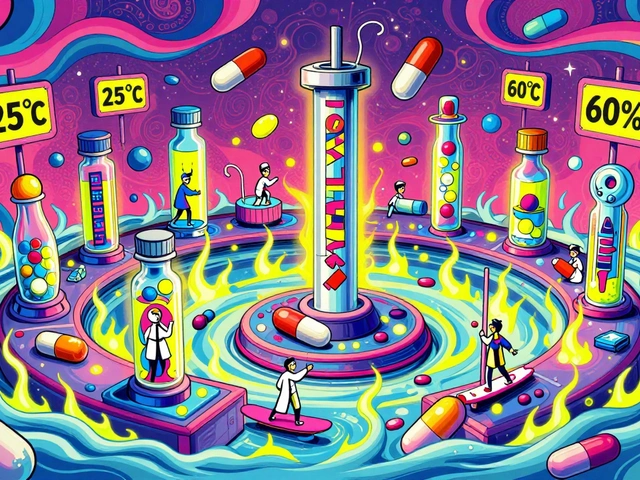
Agranulocytosis Monitoring Calculator
Medication Monitoring Schedule Calculator
Calculate your blood test schedule based on medication type and treatment duration. Early monitoring is crucial to prevent life-threatening infections from agranulocytosis.
What Is Agranulocytosis and Why Does It Matter?
Agranulocytosis is a rare but deadly condition where your body stops making enough neutrophils - the white blood cells that fight off bacteria and fungi. When your absolute neutrophil count (ANC) drops below 100 per microliter, you’re at serious risk. Even a minor cut or a sore throat can turn into a life-threatening infection. It doesn’t happen often, but when it does, it happens fast. And most of the time, it’s caused by a medication you’re taking.
Up to 70% of all cases are linked to drugs. That means if you’re on certain prescriptions, your body might be quietly shutting down its main defense system. The scary part? You might not feel sick until it’s too late. Fever, chills, mouth sores, or a sore throat are often the first signs - but they’re easy to mistake for the flu. By the time you see a doctor, your infection could already be spreading.
Which Medications Are Most Likely to Cause It?
Over 200 medications have been tied to agranulocytosis, but only a few carry real risk. The big ones are:
- Clozapine - used for treatment-resistant schizophrenia. The risk is low - about 0.8% - but the consequences are severe. That’s why the FDA requires weekly blood tests for the first six months.
- Propylthiouracil and methimazole - used for overactive thyroid. Propylthiouracil carries a higher risk than methimazole. Patients on this drug should get blood work done every 2-4 weeks during the first 6 months.
- Trimethoprim-sulfamethoxazole - an antibiotic. People taking this have nearly 16 times the risk compared to those on other antibiotics.
- Dipyrone - a painkiller banned in the U.S. but still used in Europe and Latin America. It’s linked to 1.2 cases per 10,000 patient-years.
Most other drugs - like ibuprofen or amoxicillin - have negligible risk. But if you’re on clozapine or an antithyroid drug, don’t assume you’re safe just because you feel fine. The damage happens silently.
How Your Body Reacts: Immune Attack vs. Bone Marrow Shutdown
Not all drug-induced agranulocytosis works the same way. There are two main mechanisms:
- Immune-mediated (about 60% of cases): Your immune system mistakes your own neutrophils for invaders. The drug sticks to the surface of these cells, and your body starts destroying them. This can happen suddenly - sometimes within days of starting the medication.
- Bone marrow suppression (about 40%): The drug poisons the stem cells in your bone marrow that make neutrophils. This is slower. It usually takes weeks or months before counts crash.
Knowing which type you’re dealing with helps doctors decide what to do next. If it’s immune-related, stopping the drug is usually enough. If it’s bone marrow damage, recovery might take longer - and you might need growth factors like G-CSF to jumpstart production.
Monitoring: The Only Way to Catch It Early
There’s no way to predict who will develop agranulocytosis. That’s why monitoring isn’t optional - it’s life-saving.
For clozapine, the rules are strict: weekly blood tests for the first 6 months, then every 2 weeks for the next 6 months, then monthly after that. If your ANC drops below 1,000/μL, treatment stops. If it falls below 500/μL, you’re in emergency territory.
For antithyroid drugs, guidelines vary, but most experts recommend testing every 2-4 weeks for the first 3-6 months. After that, monthly checks are usually enough - unless you develop symptoms.
But here’s the problem: studies show that only about two-thirds of doctors follow these rules. Some patients miss appointments. Others live far from labs. That’s why new tools like the Hemocue WBC DIFF device are changing the game. It gives a full blood count in under 5 minutes - right in the clinic. In trials, it improved monitoring adherence by over 30%.

What Happens If You Get Infected?
Febrile neutropenia - fever with ANC below 500/μL - is a medical emergency. It’s not the same as a cold. This is sepsis waiting to happen.
The Infectious Diseases Society of America says: if you’re on a high-risk drug and you have a fever over 38.3°C (101°F), start broad-spectrum antibiotics immediately. No waiting. No delays. You need coverage for Pseudomonas aeruginosa - a bacteria that thrives in low-immunity environments.
Without treatment, mortality can hit 20%. With prompt antibiotics and stopping the drug, it drops to under 5%. That’s the difference between life and death.
What If You’re Already Diagnosed?
If you’re diagnosed with medication-induced agranulocytosis, the first step is always the same: stop the drug. Immediately.
Recovery usually takes 1-3 weeks. Your neutrophils will start coming back on their own. But during that time, you’re vulnerable. Stay away from crowds. Wash your hands constantly. Avoid raw meat, unpasteurized dairy, and undercooked eggs. Even fresh flowers or houseplants can harbor mold that’s dangerous when your immune system is down.
In severe cases, doctors may give you G-CSF (granulocyte colony-stimulating factor), a drug that forces your bone marrow to produce more neutrophils. It’s not always needed, but it can cut recovery time in half.
New Tools and Future Changes
Things are getting better. In early 2023, the FDA approved the first genetic test for clozapine-induced agranulocytosis: the HLA-DQB1*05:02 test. If you carry this gene variant, your risk is 14 times higher. Testing for it before starting clozapine could prevent cases before they start.
Also in 2023, the European Hematology Association updated its guidelines. They now recommend acting when ANC drops below 1,000/μL - not 500. Why? Because 78% of serious infections happened in people whose counts were already below 1,000. Waiting until 500 was too late.
AI-powered alerts in electronic health records are also helping. A 2022 study found these systems reduced missed cases by 47%. They flag patients on high-risk drugs who haven’t had a blood test in 45 days - and send automatic reminders to doctors and patients.

Why This Matters for You
If you’re on clozapine, propylthiouracil, or trimethoprim-sulfamethoxazole, this isn’t just medical jargon. It’s your safety plan.
Don’t skip blood tests. Don’t ignore a sore throat. Don’t assume your doctor knows the risks - many don’t. Ask: “Is this drug linked to low white blood cells? What should I watch for? When’s my next test?”
And if you’re a caregiver or family member - pay attention. Patients often don’t realize how serious a low-grade fever can be. If someone on one of these drugs gets a fever, treat it like an emergency. Go to the ER. Don’t wait.
What About Other Drugs?
Most medications are safe. But if you’re taking something new and develop unexplained fever, fatigue, mouth ulcers, or swollen gums - get your blood checked. Don’t wait for your next appointment. Call your doctor the same day.
The European Medicines Agency classifies drugs into three risk tiers:
- Tier 1 (High risk): Clozapine, propylthiouracil, dipyrone - require strict monitoring.
- Tier 2 (Moderate risk): Certain anticonvulsants, some chemotherapy drugs - periodic monitoring advised.
- Tier 3 (Low risk): Nearly everything else - routine monitoring is not needed.
If your drug isn’t on the high-risk list, you’re probably fine. But if you’re unsure - ask. It’s better to be safe than sorry.
Global Gaps and Inequalities
Monitoring works - but only if you have access. In Germany, 99% of patients on high-risk drugs get timely blood tests. In low-income countries, only 1 in 3 do. Rural patients in the U.S. are 2.3 times more likely to die from this condition because they can’t get to a lab in time.
Point-of-care testing, telehealth check-ins, and mobile labs are starting to close that gap. But until everyone has equal access, the risk remains unevenly distributed.
Can agranulocytosis be reversed?
Yes, in most cases. Once the triggering medication is stopped, the bone marrow usually recovers within 1 to 3 weeks. Neutrophil counts begin rising again naturally. In severe cases, doctors may prescribe G-CSF to speed up recovery. But recovery depends on how quickly the condition was caught - delays increase the risk of fatal infection.
How often should I get blood tests if I’m on clozapine?
The FDA requires weekly complete blood count (CBC) tests for the first 6 months. Then biweekly for months 7-12. After that, monthly tests are sufficient - as long as your neutrophil count stays above 1,000/μL. If your count drops below 1,000, treatment stops immediately. Never skip a test, even if you feel fine.
What are the early warning signs of agranulocytosis?
The most common signs are fever over 38.3°C (101°F), sore throat, mouth ulcers, chills, and extreme fatigue. Many patients mistake these for a cold or flu. If you’re on a high-risk medication and develop any of these symptoms, get a blood test immediately. Don’t wait.
Is agranulocytosis always caused by medication?
No - but medication is the most common cause, accounting for about 70% of cases. Other causes include autoimmune diseases, viral infections like hepatitis or HIV, radiation, and rare genetic disorders. However, if you’re on a drug known to cause it, medication is almost certainly the trigger.
Can I ever take the drug again after developing agranulocytosis?
Almost never. Re-exposure to the same drug carries a very high risk of recurrence - often more severe than the first time. Once you’ve had drug-induced agranulocytosis, you should avoid that medication for life. Your doctor will find an alternative treatment.
Are there any new tests to predict who’s at risk?
Yes. In 2023, the FDA approved the HLA-DQB1*05:02 genetic test for clozapine. People with this gene variant have a 14-fold higher risk of developing agranulocytosis. Testing before starting clozapine can help avoid the condition entirely. It’s not yet routine everywhere, but it’s becoming standard in major hospitals.






Prem Hungry
November 18, 2025 AT 04:44Leslie Douglas-Churchwell
November 18, 2025 AT 14:14shubham seth
November 20, 2025 AT 01:04Kathryn Ware
November 20, 2025 AT 17:45kora ortiz
November 22, 2025 AT 06:13Jeremy Hernandez
November 23, 2025 AT 18:04Tarryne Rolle
November 23, 2025 AT 20:33Kyle Swatt
November 24, 2025 AT 22:42henry mariono
November 25, 2025 AT 22:38Sridhar Suvarna
November 27, 2025 AT 20:57Joseph Peel
November 28, 2025 AT 05:18Kelsey Robertson
November 28, 2025 AT 05:29Joseph Townsend
November 28, 2025 AT 07:20